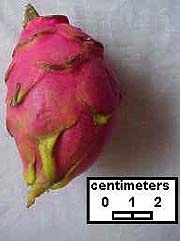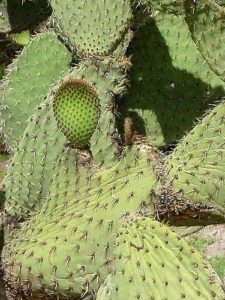Spiny, tough and menacing, the cacti seem peculiar choices as culinary delights. Cacti are well known novelties among potted plant collectors and gardeners, and some cacti, such as nopales (the stems of prickly pears) and tunas (cactus fruits) have recently gained popularity as a healthy foods outside of Mexico. However, the cactus is nothing new in the Mexican diet, and, in some parts of the country, certain cactus products are still seasonally elemental table fare.
The cactus family (Cactaceae) has more than 1,000 different species. Cacti are thick-stemmed, generally spiny, mostly leafless plants unique to the Americas, and Mexico is the world’s center of cactus diversity. Edible portions of the cacti include the stems and the fruits.
Nopales. In Mexico, nopales, the edible stems (or pads) of the prickly pear cactus, probably make up most of the cactus products consumed. They are thick, green, and fleshy, and, when used in stews or salads, they have a flavor and texture vaguely similar to that of green beans. These prickly pear pads are an important vegetable in the Mexican diet, and, in some regions, they even serve as a dietary staple during certain seasons.
The edible nopal is actually the young, tender branch of a prickly pear plant. The spines are barely developed (but nevertheless irritating) at the time of harvest, and the campesinos (field laborers) who harvest them remove them and clean the pad before taking it to market. Vendors sell nopales as entire pads or diced and packaged (nopalitos) in neatly tied plastic bags for a quick, rinse and serve dish. Some grocery stores even sell pickled nopales, which are delightful salad garnishes.
 In Mexico, the nopal becomes especially important table fare during “vigilia” (Mexican Catholic Lent), when the Church frowns upon the consumption of meat. In predominantly Catholic Mexico, nopalitos sautéed with scrambled eggs, and diced onion, chile, and tomato adorn the breakfast (desayuno or almuerzo) table and even appear during the midday meal (la comida). Nopalitos also fare well in stews with other vegetables, and, in lieu of the celebration of Lent, with red meats. Cooking stews with nopales requires a little practice and experimentation because they tend to become slimey (baboso), like okra, when cooked in water, or when cooked with too many other moist vegetables. Salads made with nopalitos have an agreeable texture and a comfortably filling “heft.” Pickled nopalitos, combined with other pickled vegetables, like carrots, jalapeños, and onions, plus a little seasoning, make refreshing light meals on hot, lazy afternoons.
In Mexico, the nopal becomes especially important table fare during “vigilia” (Mexican Catholic Lent), when the Church frowns upon the consumption of meat. In predominantly Catholic Mexico, nopalitos sautéed with scrambled eggs, and diced onion, chile, and tomato adorn the breakfast (desayuno or almuerzo) table and even appear during the midday meal (la comida). Nopalitos also fare well in stews with other vegetables, and, in lieu of the celebration of Lent, with red meats. Cooking stews with nopales requires a little practice and experimentation because they tend to become slimey (baboso), like okra, when cooked in water, or when cooked with too many other moist vegetables. Salads made with nopalitos have an agreeable texture and a comfortably filling “heft.” Pickled nopalitos, combined with other pickled vegetables, like carrots, jalapeños, and onions, plus a little seasoning, make refreshing light meals on hot, lazy afternoons.
Fruit juice drinkers might enjoy a high-fiber drink prepared from orange juice, nopales, and a smattering of pineapple. Nopales, with their clean, docile flavor combine well with many other fruits and vegetables.
Health food stores sell nopal cookies ( galletas de nopales), which texturally resemble bran cookies. Nopales provide dietary aid for diabetes sufferers, and their high fiber content is beneficial to nearly any diet. Natural produce nutritionists tout nopal en polvo (powdered prickly pear pads) and Opuntia (Opuntia is the scientific name for prickly pears) capsules as dietary supplements useful in promoting weight loss. Numerous other nutritional and health benefits have been linked to this fleshy vegetable.
Tunas and Pitayas. All cacti produce fruits, and, again, the genus Opuntia, or the prickly pears, produce the main portion of cactus fruits that appear on the Mexican edible fruit market. Prickly pear fruits, known as “tunas,” vary in size from small, guava- ( guayaba-) or plum-sized fruits to larger kiwi-sized fruits. They have a thick, leathery peel dotted with areolas (colored rings, generally at the base of spines in cacti) loaded with irritating glochids. The glochids are tiny, nearly microscopic spines with barbs. They are extremely irritating and difficult to remove, so one must use precaution when peeling a tuna. Children who eat tunas in the field often brush them off with a clump of grass before handling them.
 The pulpy fruit within the tougher peel resembles watermelon or kiwi fruit flesh, but it’s filled with fairly large (BB shot sized), moderately hard seeds. Most people eat them along with the pulp. Despite the seeds, the juicy, fruity flavor of chilled prickly pear tunas provides refreshing relief from hot, sun-baked afternoons. Tuna flavor is akin to that of the kiwi fruit, but it’s not quite so acidy.
The pulpy fruit within the tougher peel resembles watermelon or kiwi fruit flesh, but it’s filled with fairly large (BB shot sized), moderately hard seeds. Most people eat them along with the pulp. Despite the seeds, the juicy, fruity flavor of chilled prickly pear tunas provides refreshing relief from hot, sun-baked afternoons. Tuna flavor is akin to that of the kiwi fruit, but it’s not quite so acidy.
Mexican tunas appear in fruterías (fruit stores) and roadside puestos (fruit or food stands) as tunas blancas (literally, white prickly pear fruits) and tunas coloradas (red prickly pear fruits). Both are delicious, with their own distinct flavors. The tunas blancas are actually honeydew melon green, and not white, as the literally translated name might suggest. The red fruits, when ripe, are much sweeter, but have larger, more abundant seeds.
Much lesser known, but undoubtedly a delicacy among the Mexican fruits is the pitaya. Pitayas rarely reach the size of tunas, and they generally grow in much smaller, less easily harvested numbers. However, their many distinct, delicate flavors and tiny seeds make them desert delights. Although all cacti produce fruits, some harden and dry or have too many seeds to make them palatable. The scarcity, small size, and ephemeral (or short-term) nature of these fruits make them delicacies enjoyed only by a few campesinos and adventurous hikers.
A novelty to foreign visitors, the cactus is as common on the Mexican plate as potatoes or rice in many other parts of the world. The nopal is a versatile and healthy vegetable both cooked and green. Cactus fruits, or tunas and pitayas, are great sweet desserts and snacks for those hot Mexican desert afternoons in the shade.
Some Recipes, Sources & Festivals:
- Nopales: Cooking with Cactus
- Huaraches: Stuffed Nopales
- Nopales en Chipotle Adobado: Nopales in Chipotle Sauce
- Ensalada de Nopalitos: Nopal Salad
- Nopales Salad #2
- Nopales Rellenos: Stuffed Cactus Paddles ( En Español)
- Codillo Aquiahuac
- Nopales/Nopalitos products
- April 29-30 Tlaxcalancingo, Puebla, Festival de Nopales – Nopal Festival.
Jeffrey R. Bacon Professor and Research Scientist, Universidad Juárez del Estado de Durango, Cd. Durango, Dgo.
Published or Updated on: August 24, 2007






